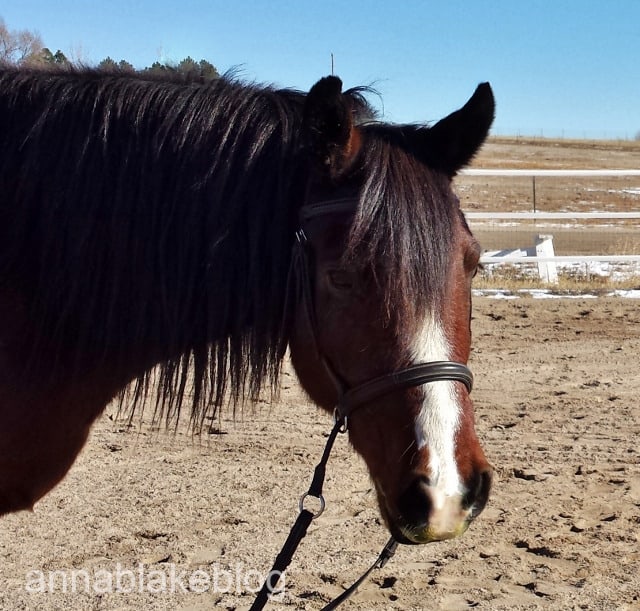 Most of us read the training books and do the best we can to apply them in the saddle. We all think we define those words the same way, but we don’t all get great results.
Most of us read the training books and do the best we can to apply them in the saddle. We all think we define those words the same way, but we don’t all get great results.
Maybe you aren’t a flawless rider but you’re not a total disaster in the saddle either. If you are in the immense gray area of riders in the middle and trying to do better, consider this: A small adjustment in timing can make a huge difference. There’s an instant where a horse and human partnership becomes adversarial, and I want to magnify that instant big enough to recognize, so you can have a do-over. Humor me, this gets a little fussy on paper.
Say your horse doesn’t want to go forward (or whatever.) You know enough to ask small first and then escalate if the horse doesn’t respond. You’re ready -as the leader- to enforce the horse’s expected lazy response. Since he isn’t going forward now, you’re prepared to judge and correct, even before the first request. When you actually ask for more forward, the process goes something like this: (visualize this in your head using a pointer and a stick figure of a horse and rider, please.) The idea appears in your brain, it travels down your spine to your seat and on to your legs or feet. Eventually your horse feels the sensation and that information travels through his body to his spine and up his neck to his brain, he ponders it for a brief moment and suddenly, even rudely…
Whack! Time’s up, pencils down, time for a spanking!
Did you give him enough time? Is it possible that you interrupted him just as he was preparing to go? Maybe in the same instant he was answering, you judged him as disobedient and escalated the cue, with more leg or maybe a tap with the whip. (This is the important instant!) If the timing is off, it can feel to the horse like he just got punished for trying. If the correction was too fast or hard, he wonders if the first cue was not a cue for forward, but instead a warning that a correction was on the way. Then instead of going forward at the first cue, he’s learned to learned to anticipate the wrong thing.
Next the rider prepares for an even bigger cue. This is going to need strength (we think), and maybe he will resist more, so the seat stops following and the legs grab on (the cue for a half halt, if not a full halt) and the reins get tight because that’s what the rest of the body did. Lots of horses consider set hands that don’t follow the exact same thing as pulling back on the reins. You can disagree but he’s actually the one who gets to judge this part. Now the leg kicks hard enough to bruise a rib. It’s a conflicting message, legs say Forward but seat and hands say Don’t you dare.
Here’s the problem: Your brain is spinning for obedience so you don’t notice how much the rest of your body is working against it. You’ve seen other riders here, haven’t you?
And by the way, as you have been thinking in your head about what to do, and he’s been trying to respond somehow in his confusion, your partnership has become adversarial. Frustrated. And now both of you are thinking Whatever I do is wrong! Have three minutes passed since the first ask for forward? How’s the ride going so far?
Here’s the do-over: Rewind back to the first ask for forward. You asked lightly and while the message is traveling back and forth, you breathe. Give him the benefit of the doubt and just as you are ready to escalate the first time, be patient and take one more deep breath. He will most likely go on that inhale. If he gives you a tiny half-stride more forward, praise him for doing what you asked. Then repeat. When his try is rewarded, he learns in hindsight that he has done the right thing, and that builds confidence. Literally. No one is in a defensive mode and both of you are at Whatever I do is right! (or at least headed that way.)
They say the definition of insanity is doing the same thing and expecting a different result. It follows that if your horse needs improvement, it has to start with you. For a rider that means improving your perception in the saddle and illuminating the dark little corners of communication. The training conversation has to go deeper than the surface perception.
Does this method seem slow? Should a leader demand more, better, faster? It’s absolutely true we want our horses to be more responsive, but that’s trained differently. It’s lots of walk-trot transitions that pave the path to enlightenment! In the beginning of the ride, the transitions won’t be perfect. Say thanks and ask again. Tune him up by rewarding the good, that’s a far different intention than correcting.
Horses and riders are always working on a tendency towards partnership but we even define that differently. Do you want dominance or responsiveness? Seriously, they are not the same thing. The reason this instant in the timing of a cue matters so very much, is that it’s the moment when you let your horse know who you really are.
Anna Blake, Infinity Farm.
You need to be a member of Barnmice Equestrian Social Community to add comments!
Join Barnmice Equestrian Social Community